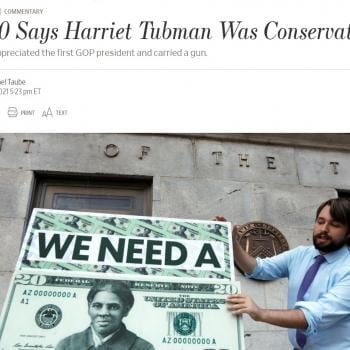Several weeks ago I ran a four-post series looking at conservative theologian Doug Wilson’s views of slavery and race. But there’s one point I realized afterwards I left unaddressed—and it’s an important point, because it’s one often used by anti-abortion activists to inject race into the conversation. In his 2005 book, Black and Tan, Wilson wrote the following:
Who cannot lament the damage to both white and black that has occurred as a consequence of the way in which slavery was abolished? I am forced to say that, in many ways, the remedy which has been applied has resulted in problems that are every bit as bad as the original disease ever was. Christians who doubt this should consider whether it was safer to be a black child in the womb in 1858 or in 2005. (p. 58)
Wilson is of course trying to argue that it was safer to be a black child in the womb in 1858, even facing a life of slavery, than it is in 2005, with the high abortion rate among African American women. And Wilson isn’t alone. The argument that abortion is a worse catastrophe for African Americans than slavery was is common fare among anti-abortion advocates.



I also wrote recently about the problems with the way anti-abortion activists—including Wilson—portray abortion as an African American genocide. For one thing, it ignores black women’s agency, and for another thing, the focus is in the wrong place—those interested in reducing the number of abortions should focus on making effective birth control more available (research makes it clear that that access to longterm contraceptives substantially cuts the abortion rate) and on reducing poverty (seven in ten women who have abortions cite financial reasons for doing so).
But now let’s turn back to Wilson’s assertion that “it was safer to be a black child in the womb” under slavery than it is today. Wilson’s argument, of course, is that a large number of African American fetuses are aborted today and thus are never born and never live, while African American fetuses under slavery could expect to be born and to live, even if their lives would be difficult. Wilson did not take the time to think through this argument, however. I ran some numbers, and it turns out that a black fetus today has a higher likelihood to come to term and live to adulthood than a black fetus did during slavery.
Do you know what historians estimate the rate of child mortality under slavery was? A full 50%. Yes, you read that right. Remember that the child mortality rate does not include miscarriages or induced abortions—it only includes deaths that happen after birth. A full 50% of children born into slavery died in childhood. Of course, African Americans also had higher rates of fetal death than the rest of the population at the time, because of slavery:
A major contributor to the high infant and child death rate was chronic undernourishment. Slaveowners showed surprisingly little concern for slave mothers’ health or diet during pregnancy, providing pregnant women with no extra rations and employing them in intensive field work even in the last week before they gave birth. Not surprisingly, slave mothers suffered high rates of spontaneous abortions, stillbirths, and deaths shortly after birth. Half of all slave infants weighed less than 5.5 pounds at birth, or what we would today consider to be severely underweight.
Growth rates among slave children were extremely slow. Most infants were weaned early, within three or four months of birth, and then fed gruel or porridge made of cornmeal. Around the age of three, they began to eat vegetables soups, potatoes, molasses, grits, hominy, and cornbread. This diet lacked protein, thiamine, niacin, calcium, magnesium, and vitamin D, and as a result, slave children often suffered from night blindness, abdominal swellings, swollen muscles, bowed legs, skin lesions, and convulsions. These apparently stemmed from beriberi, pellagra, tetany, rickets, and kwashiorkor, diseases that are caused by protein and nutritional deficiencies.
Today, around third of all pregnancies end in miscarriage, often before a woman knows she is pregnant. In the antebellum period, this number was higher across the board, in part because they didn’t have modern medical conveniences and things like rhogam shots—but it was even higher for African American women in slavery, because of chronic underfeeding and overworking. And again, this is on top of the tragic reality that 50% of all African American children born in slavery did not survive the first few years of their lives.
And now let’s turn to abortion rates today. Anti-abortion activists often claim that “half of all black babies are aborted,” but this is actually a falsehood created by a misreading of statistics:
See, the “half of all black babies are aborted” line immediately stood out for me, because I’ve written about this very lie before. Lila Rose (better known for her “sting” operations on Planned Parenthood with none other than James O’Keefe) used this lie in her pro-life magazine, ironically called The Advocate. The statistic is pure bullshit. I found where that made-up statistic came from: a blatant misreading of the original 2004 CDC report (scroll down to the “Results” section).
“In the 38 reporting areas for which race was provided, classified according to the same categories used in previous years, approximately 53% of women who obtained legal induced abortions were white; 35%, black; and 8%, other; race was not known for 4% (Table 9). The abortion ratio for black women (472 per 1,000 live births) was 2.9 times the ratio for white women (161 per 1,000), and the ratio for women of the nonhomogeneous “other” race category (330 per 1,000) was 2.0 times the ratio for white women.”
That’s what the person saw. The numbers 472 and 1,000, and so it must mean 47.2%, which is “almost half”! Except… it’s a RATIO, not a percentage. Those “1,000 live births” are just that; babies that are actually born, i.e., not aborted. If you want the percentage, it’s 472 / (472 + 1000) = 32%. (FYI, the percentage for whites is 13.9%.) Now, I don’t want to get into a debate on whether 32% is too high of a number. But we simply don’t refer to a percentage that less than one-third as being “almost half”! Well, unless you’re a pro-lifer, I guess.
Hope this clarifies. Any time one of these Republican pro-lifers tries to throw the bullshit “50%” statistic out there, someone NEEDS to call them out on that, and explain that that figure is an outright LIE.
In other words, someone saw that the CDC reported that the abortion ratio for black women was “472 per 1,000 live births” and assumed the 472 abortions were part of the larger 1,000 figure rather than in addition to it. The more accurate number, then, is about a third—for every African American woman who has an abortion, two others have live births. This rate is still high, of course, and it’s higher than the rate of abortion for white women (again, for reasons), but one-third lacks some of the shock value of one-half.
How do these numbers compare to the numbers under slavery? Let’s return to Wilson’s rhetorical question—is it “safer to be a black child in the womb” today, or in 1858? For each period, we need to add fetal death and child mortality. During the antebellum period, roughly 50% of slave children died within the first few years of life, and the rate of miscarriage and stillbirth was inflated by the trauma of slavery. Today, roughly 32% of African American pregnancies end in abortion, and the rate of child mortality for African American children is 1.37%. While estimating maternal miscarriage among antebellum slaves is tricky, I think we can safely say that an African American pregnancy today is at least twice as likely to result in the birth of a child who lives to adulthood than was an African American pregnancy in 1858.
And if that doesn’t underscore the evils of slavery, I don’t know what does.
Some may object to me adding these two numbers together and argue that Wilson only meant to count dangers before birth, and not child mortality. The problem with this argument is that what Wilson is really doing is asking whether someone would be better off in a black womb today or in a black womb under slavery. His goal is clearly to point to the high rate of abortion today to make the black womb today sound more dangerous than the black womb under slavery. But to do this and ignore the astronomically high rates of child fatality under slavery, the bulk of which likely occurred during the first year of life, is misleading and dishonest.
Besides, the black womb under slavery was not the safe place Wilson thinks it, given the high rate of slavery-induced miscarriage and (frankly) the high rate of miscarriage in general (in the absence of modern medicine). Indeed, the increased risk of fetal death for antebellum slaves could have reached the current African American abortion rate (I literally could not find numbers on this though, so we can’t say for sure).
Both Wilson and anti-abortion advocates who discuss African American abortion rates in the same breath as slavery are ignoring and discounting the incredible horrors of slavery. They are ignoring the pain of African American women subjected to inhumane conditions and African American children who withered and died for lack of food and proper medical care. Any suggestion that African Americans are worse off today because one-third of African American pregnancies end in abortion must of needs ignore the horrific dangers of slave pregnancies and the 50% of African Americans who died as infants and young children. This is unconscionable.
And let me ask one last question. Let’s imagine for a moment that Wilson is right about the relative danger. Let’s say that 50% of African American pregnancies today end in abortion (they don’t, but he probably thinks they do) and that antebellum slavery had a child mortality rate comparable to today and no increased rate of miscarriage (again, this is not the case, but Willson has clearly never considered these factors). What would you prefer: To be a fetus in an African American womb today, with a 50% chance of coming to term and being born as a free person in today’s world? Or to be a fetus in an African American womb in 1858, with a 100% chance of coming to term and being born and living the life of a slave? I put this question to my husband and he immediately took the 50% odds. In his discussion of antebellum slavery, Wilson ignores the many African Americans took odds not unlike this, risking life and limb to obtain freedom.
There are some things that are worse than death.
* This entire conversation ignores the fact that it is absurd to compare abortion and child fatality, because aborted fetuses (remember that the vast majority of abortions occur during the first trimester) never have a conscious thought and thus don’t know what is lost, and women who have abortions do not typically suffer the heartrending horror of losing a child. Any attempt to compare abortion today to the absolute horror of antebellum slavery is absurd to the extreme. The only reason I took the time to lay out the numbers in this post is that I wanted to show that Wilson loses even on the terrain he has set up.














